In 1909, Covina made big sports headlines. That year, the town boasted a semi-pro baseball team that went undefeated its entire first season. A remarkable feat in itself, but what followed was arguably the most momentous sporting event to ever take place in Covina, when the major league Chicago White Sox came here to play the amateur champs. Yet surprisingly, this remarkable story was mostly lost to history... until now.
Our story begins with George E. Covert, a bona fide real estate wunderkind. He closed his first sale when he was only 17, and in 1908, at the age of 23, he sold almost $100,000 worth of orange and walnut groves in a single month.1 So what does a young hot shot do with that kind of money? Well, George just happened to be a sports fan, so he organized a ball club to represent and promote his adopted town of Covina.2
His first team–which he called the White Squadron–was formed in December, 1908,3,4 and was manned mostly with homegrown raw talent.5 Home games were played at the ball grounds located on leased land4,5 at the foot of Citrus Avenue,6 which at that time was where the I-10 freeway is today.7 Admission was 25¢,8 and the popular Sunday afternoon games attracted hundreds of fans.9
Covert's financial support also paid for much-needed improvements to the field and bleachers,6 and snazzy new uniforms that were clearly tailored to impress.3 According to the Los Angeles Herald:
The body of [Covina's] suits will be white, with green trimmings, and the same color scheme will be carried throughout, the coat being green with white cuffs, white pearl buttons, white old English "C" on left breast. Small green "C" showing through white diamond on sleeves of coat. Breeches will have a small green bead running down outside seam, the caps having the same kind of bead on the seams. Stockings will be green, with a broad white band.4
And here are the Covina boys, all gussied up in their fancy new finery.
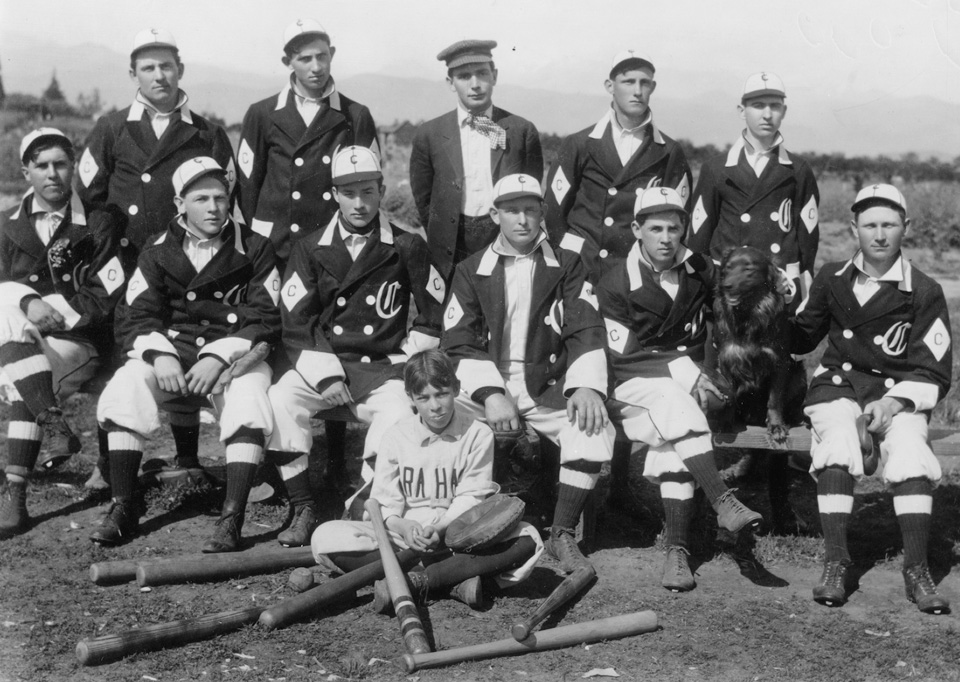
The Covina White Squadron, March, 1909.
Standing: Stewart, 2b; Pitts, p,1b; Covert (Manager); "Bab" Fairly, rf; Shirley, 3b.
Seated: King, c; ?Hooker, cf; Hughes, ss; "Ping" Fairly, p,of; Libby, 1b (Captain);4 team mascot; Montague, lf.
Photo courtesy Mark Thiel, Powell Camera Shop, Covina.
Cobbling together as many game results as I could find in newspapers of the day, the White Squadron ended its 1909 spring season with no fewer than 19 wins to only 9 losses (.679), which was pretty darned respectable for a first showing. The best was yet to come, though. For the organized summer league, Covert assembled a new team with many of the same players, and secured a financial sponsorship from the company that made the "San Felice" brand of cigars.10
As good as the White Squadron had been, Covina San Felice was a true powerhouse. With their almost unhittable pitcher Charlie Miller and three position players batting in the .400s,11 San Felice steamrollered opponents left and right, massively outscoring them by a combined 142-36 runs.12 The "Orange Pickers" (as the Covina fans called them)13 went undefeated in their league play with a record of 13-0-1; the only blemish on an otherwise perfect season being a 4-4 tie with Wells-Fargo in their final game.14,15
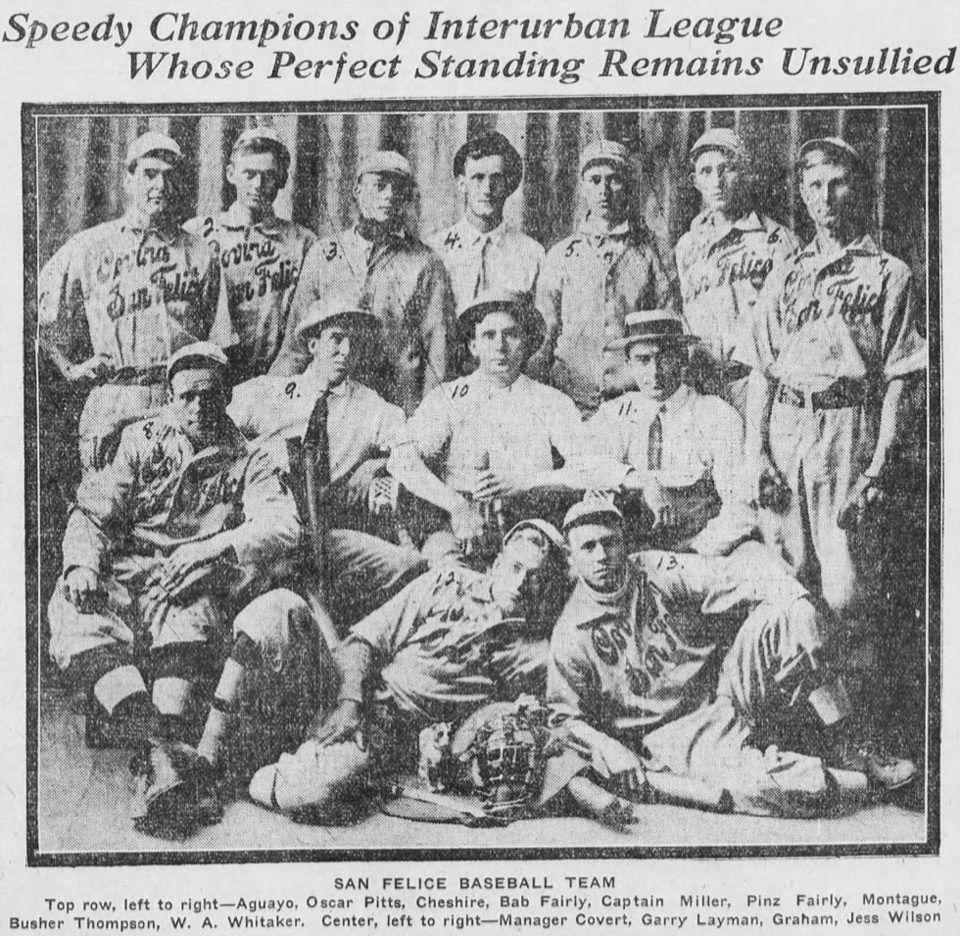
Covina San Felice, Los Angeles Herald, September 26, 1909. (To read the accompanying writeup, click here.)
A better caption, by the numbers: 1) Pete "Silver Heels" Aguayo; 2) Oscar Pitts; 3) "Chess" Cheshire; 4) Chase "Bab" Fairly;
5) Team Captain Charlie Miller; 6) Chester "Ping" Fairly; 7) Glenn "Monty" Montague; 8) "Busher" Thompson;
9) William Whitaker; 10) Manager George "Mugsy" Covert; 11) Coach Garry Layman; 12) H. Graham; 13) Jess Wilson.
The following February, it was announced with great excitement that the American League Chicago White Sox were coming to Covina during their spring barnstorming tour to challenge the now-famed town team.
The phenomenal record of the Covina San Felice playing in the Interurban League [...] has drawn the attention of those higher up in the baseball world, with the result that the White Sox, one of the most perfect playing machines in the world, will play here.
When the Sox arrive in the morning [of March 7th], they will be met by auto and taken on a trip through the valley, visiting the towns of Azusa, Glendora, Pomona, etc., where an opportunity to see the orange in its home will be given them. At 12 o'clock the team will be given a banquet at the Hotel Vendome, after which the game will be called.16
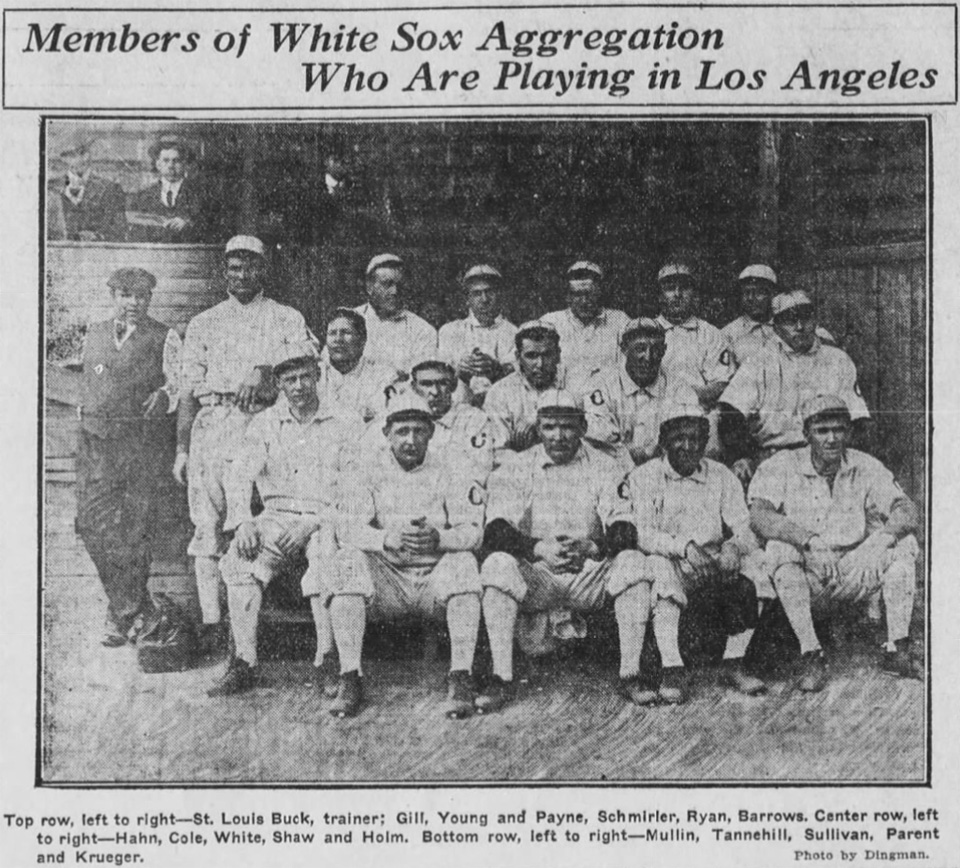
The White Sox team that played in Covina in 1910. Los Angeles Herald, March 8, 1910.
The Covina squad that was assembled to host the White Sox was not the same San Felice roster that won the league championship the previous fall, however. In fact, by the time the Sox arrived, the only remaining San Felice team member still playing for Covina was outfielder Montague. Despite this, the locals were expected to put up a good fight against the visiting pros, and in terms of effort, anyway, they did not disappoint.
The headline of the Covina Argus the day after the big game should give you an idea of how the locals reacted to the Sox coming to town.
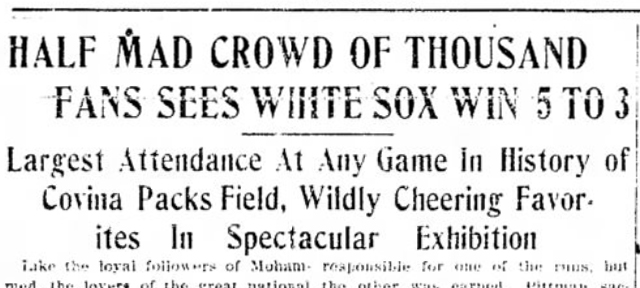
Covina Argus, March 12, 1910.
And the box score:
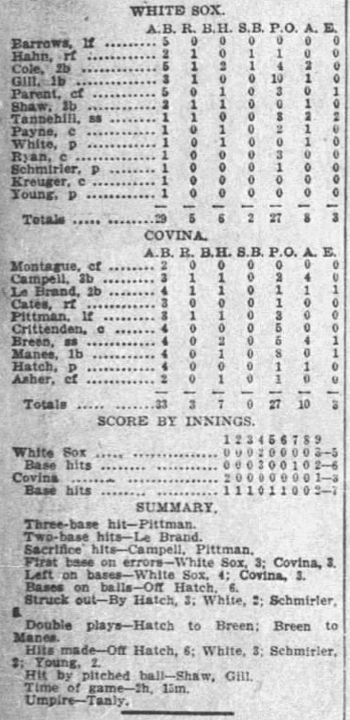
Los Angeles Times, March 8, 1910.
So, as might be expected, Covina did lose to the big leaguers, but it turned out to be far from a mismatch. The opposing teams shut each other out in the early going, then went toe-to-toe tied at 2 runs apiece from the 4th to the 9th when the visitors scored 3 runs and the home team could only answer with 1. The Sox's winning edge proved to be the two relievers that they were able to call on in the late innings, while Covina's pitcher had no backup and had to go the distance on his own. (I daresay if their former ace, Miller, were still with Covina then, they probably would've whupped the Sox.)
Unfortunately, as fate would have it, that day was the high water mark for Covina as far as organized baseball was concerned. Later in 1910, Covert managed a new local squad called Covina El Portana,17 and attempted to form another in 1911,18 but neither really amounted to anything. After that, for reasons untold, Covert gave up on baseball, and fans of the game in Covina would have to be content rooting for their high school nines from then on.
George Covert departed for Merced County in 191619 where he apparently believed real estate pastures were greener, but as with his baseball teams, he never again attained the level of success he had in Covina. He died there in 1954 at the age of 71.20
Several of the ballplayers remained in and around Covina, however, working local jobs and getting together every once in a while for pick-up games or charity. The motley crew of "old timers" pictured below was assembled to play for the Odd Fellows on Washington's Birthday, 1911. They went down to ignominious defeat at the hands of the Masons, 14-5,21 but a good time was had by all as you can tell by the big smiles.
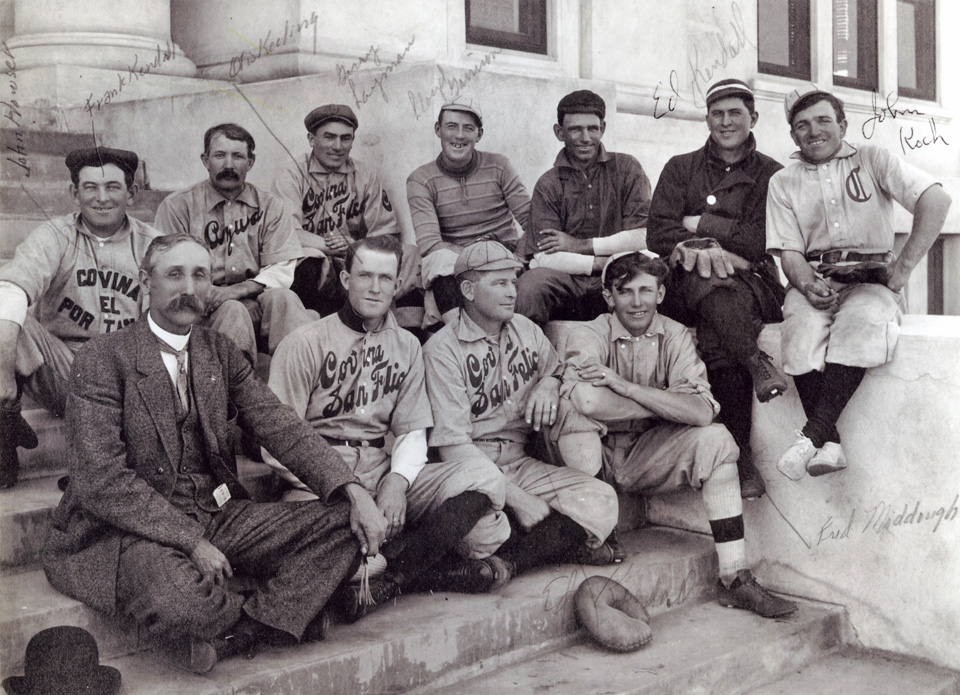
The Odd Fellows pick-up team on the steps of the old Union High School, February, 1911. Photo courtesy Mark Thiel, Powell Camera Shop, Covina.
So, there you have it. How previous historians missed chronicling these noteworthy events, I can only speculate. Heck, I didn't know about them, myself, until less than a month ago. And there's actually quite a bit more to the story than what I just related. I go up close and personal with one of the players here.

–Dedicated to my father, Ed Shannon, manager of the first Covina-area youth baseball team to play and place in the State Tournament, 1957–
Grateful thanks to Mark Thiel for the black-and-white photos of the old Covina ballplayers, and master of the search bar Michael Schoenholtz for his invaluable historical sleuthing skills.

References:
1 Covina Argus, December 26, 1908, p.3.
2 Los Angeles Herald, September 26, 1909, p.29.
3 Covina Argus, December 19, 1908, p.4.
4 Los Angeles Herald, February 28, 1909, p.21.
5 Covina Argus, February 27, 1909, p.4.
6 Covina Argus, January 3, 1909, p.1.
7 USGS topographical map, Pomona, CA, 1904 (1908 ed.).
8 Covina Argus, February 9, 1909, p.1.
9 Covina Argus, March 6, 1909, p.1.
10 Covina Argus, July 17, 1909, p.1.
11 Los Angeles Herald, September 25, 1909, p.12.
12 Box scores printed in the Covina Argus and Los Angeles Herald newspapers.
13 Covina Argus, July 31, 1909, p.4.
14 Los Angeles Herald, October 18, 1909, p.7.
15 Covina Argus, October 23, 1909, p.7.
16 Covina Argus, February 12, 1910, p.4.
17 Covina Argus, May 28, 1910, p.3.
18 Covina Argus, November 18, 1911, p.3.
19 Merced County Sun, May 26, 1916, p.4.
20 California Death Index, 1940-1997, via FamilySearch.com.
21 Covina Argus, February 25, 1911, p.4.
Clippings from Newspapers.com.
No comments:
Post a Comment
To post a comment, you must login to this page with the Google Chrome web browser. That is the only way that works now.